Mastering Basketball Dribbling: The Ultimate Guide
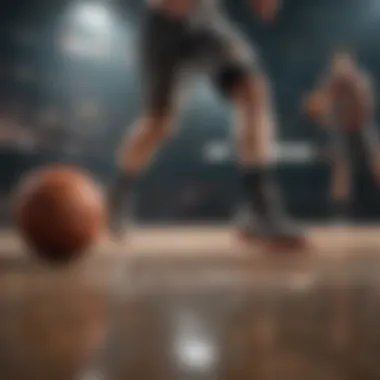

Intro
Basketball dribbling is a fundamental skill that can make or break a player's ability to perform on the court. Mastering this skill is not simply about bouncing the ball; it encompasses a range of techniques aimed at enhancing control, speed, and agility. This guide explores various dribbling programs designed to improve these essential skills. We will discuss different training methodologies, examine their benefits, and offer insights into the modern technology shaping dribbling practices.
Understanding the elements of dribbling programs helps one appreciate their significance in the overall landscape of basketball performance. From professional players to grassroot levels, effective dribbling can determine game dynamics, strategy deployment, and ultimately, victory.
Techniques and Tips
Skill Development
To develop dribbling skills, players should focus on dexterity and hand-eye coordination. Numerous drills, such as cone drills and figure-eight dribbles, are effective in building these skills. Dribbling with both hands is equally crucial. This promotes ambidexterity and prepares players for varying game situations. Training should also incorporate changes in pace and direction to simulate actual game conditions.
Practical Techniques
- Low dribble: Used for close control, particularly when driving past defenders.
- Crossover dribble: An essential move for creating separation and avoiding defenders.
- Behind-the-back dribble: Useful for protecting the ball from defenders.
- In and out dribble: A deceptive technique to mislead opponents.
By practicing these techniques regularly, players can enhance their dribbling effectiveness, making them more versatile on the court.
Common Mistakes to Avoid
It is vital to recognize and correct common errors in dribbling practices. Players often:
- Overuse one hand, limiting their adaptability in games.
- Get too upright, losing balance and control.
- Focus solely on speed without consideration for technique.
By addressing these issues, players can refine their skills more effectively.
Gear and Equipment
Essential Gear for Beginners
Selecting the right equipment is essential for practicing dribbling efficiently. Basic gear includes a suitable basketball and quality basketball shoes designed for support and traction. Players also benefit from wearing comfortable clothing that allows for full range of motion.
Latest Innovations and Trends
Modern training technology incorporates tools such as smart basketballs, which track dribbling metrics, and mobile applications offering personalized training regimens. These innovations provide valuable feedback, helping players to recognize areas for improvement.
Reviews and Comparisons
When considering gear, reviews from platforms like Reddit or basketball forums can be invaluable. Comparing different models of basketballs or shoes can provide insights into what best suits different playing styles.
Safety Measures
Essential Safety Gear
Safety should be a priority for anyone engaging in basketball practices. Proper footwear can prevent injuries. Moreover, wearing knee pads can protect against falls during intense training.
Best Practices for Safe Participation
Before beginning any practice session, players should ensure that their training environment is free of obstructions. Warm-up exercises and stretching can prevent muscle strains and improve flexibility.
Injury Prevention and Management
Players should be aware of common injuries associated with basketball, including ankle sprains and knee injuries. Regular conditioning and attention to proper technique are vital strategies for prevention.
"Investing time in understanding and practicing dribbling techniques not only enhances performance but also ensures longevity in the sport."
Spotlights on Basketball Highlights
Featured Player of the Month
Recognizing outstanding performers in the sport can inspire upcoming talents. Featured athletes often showcase exceptional dribbling skills, demonstrating how effective training translates into real-game applications.
Profiles of Prominent Players
Athletes like Stephen Curry and Kyrie Irving exemplify the benefits of well-developed dribbling programs. Their unique styles and approaches reveal the importance of combining skill with creativity in gameplay.
Prelims to Dribbling in Basketball
Dribbling is an essential skill in basketball. It enables players to move with the ball while maintaining control. This introduction sets the stage for understanding not only the mechanics but also the context of dribbling in the sport. Dribbling allows players to create opportunities for themselves and their teammates. A player skilled in dribbling can evade defenders, penetrate defenses, and set up plays.
Historical Context
The history of dribbling in basketball dates back to the sport's early days. Originally, players were required to pass the ball without moving. This limited offensive strategies and made the game less dynamic. As the game evolved, so did techniques and rules surrounding dribbling. Key moments in the late 1930s and 1940s, such as the introduction of the two-handed dribble, influenced the style and speed of the game.
Today, dribbling is highly developed, with players utilizing various techniques to navigate the court. Players like Bob Cousy and later, more modern players, redefined how dribbling can be used strategically on the court.
Importance of Dribbling Skills
Dribbling skills are not merely a requirement for playing basketball; they are crucial for becoming a successful player. An adept dribbler is often more versatile. They can perform in multiple positions and adjust their playing style as needed. Moreover, effective dribbling aids in offensive strategies. It increases a player’s ability to create space and drive toward the hoop.
Additionally, dribbling is essential in defensive scenarios as well. Players need to maintain control of the ball when challenged. Lack of dribbling skills can jeopardize possession or lead to turnovers. Dribbling skills enhance game IQ—players learn to read defenses and make quick decisions during play.
In summary, understanding the history and the significance of dribbling lays a solid foundation for player development and strategic thinking on the basketball court.
Components of Effective Dribbling
Effective dribbling in basketball hinges on several essential components. These elements work together to provide a solid foundation for a player’s ability to control the ball while navigating through the dynamic environment of a game. Each component offers specific benefits that enhance overall performance, making it critical for players to understand and develop these skills.
Ball Control
Ball control serves as the cornerstone of dribbling. It refers to a player’s ability to handle the basketball while moving, ensuring that they can accurately manage the distance and pressure needed for effective plays. Good ball control allows players to make quick changes in direction without losing possession.
Practicing drills that focus on dribbling with both hands can significantly improve this skill. Being proficient with both hands can aid in maintaining control when facing defenders or navigating tight spaces.
A solid ball control technique provides advantages such as:
- Maintaining Possession: Players are less likely to lose the ball when they can control it well.
- Confidence: Improved ball handling instills a sense of confidence during game situations, reducing hesitation.
- Versatility: Players can execute diverse strategies such as crossovers and fakes when they have strong ball control.
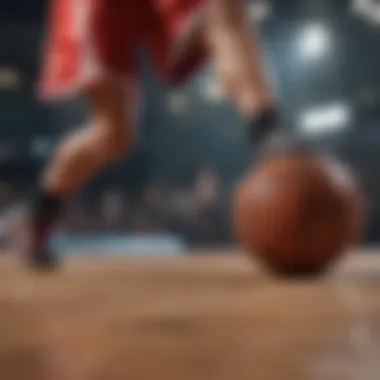

Footwork Techniques
Footwork techniques play a crucial role in a player's ability to execute dribbling effectively. Proper footwork helps maintain balance and stability during movements. In dribbling, the arrangement and movement of feet can influence a player’s ability to change speed or direction quickly.
Key footwork aspects include:
- Stance: A proper stance allows players to remain nimble and reactive.
- Pivoting: Players can pivot effectively to protect the ball, giving them time to decide on their next move.
- Change of Pace: By altering foot speed, players can confuse defenders, making it challenging for them to predict the player’s actions.
Good footwork helps a player create space, facilitating successful play execution.
Body Positioning
Body positioning involves how a player holds their body while dribbling. The ability to position oneself correctly is often overlooked but remains vital in building a successful dribbling environment. Proper body positioning can shield the ball from defenders and maintain balance during movement.
Important aspects of body positioning include:
- Low Center of Gravity: Maintaining a low stance helps players handle sudden changes in direction.
- Shoulder Placement: Shoulders should be positioned to protect the ball from opponents.
- Head Up: Keeping the head up allows players to scan the court for openings and defenders, enhancing decision-making.
By focusing on these components, players can significantly enhance their dribbling skills, ultimately leading to better overall performance in games.
"Strong fundamental skills in dribbling allow players to adapt and innovate, which is crucial in high-pressure game situations."
Types of Dribbling Techniques
Understanding various dribbling techniques is crucial for athletes seeking to elevate their game. Mastery of these techniques allows players to navigate defenses, create opportunities, and enhance overall performance. Each technique serves a unique purpose, tailored to different game situations, thus enabling a player to be versatile on the court. Let’s explore four key dribbling techniques, each offering distinct advantages and considerations.
Crossover Dribble
The crossover dribble is an essential move in basketball that involves swiftly moving the ball from one hand to the other. This technique is fundamental for any player looking to break past defenders. The speed and agility required for an effective crossover can create separation, making it easier to drive towards the basket or set up a shot.
To execute a crossover, players should focus on:
- Foot Placement: A proper stance enhances balance and allows for quick directional changes.
- Ball Control: Keeping the ball low during the move will minimize the chance of a defense stealing it.
- Deceptive Movement: Head and shoulder fakes can mislead defenders, further opening avenues for advancement.
The crossover dribble is not just about moving the ball; it’s about keeping defenders off-balance. Proper practice can lead to execution in pressure situations.
Behind-the-Back Dribble
As the name suggests, the behind-the-back dribble is executed by dribbling the ball behind the back, switching hands without losing momentum. This technique often surprises defenders by shifting the point of control out of their line of sight. It can be particularly effective when needing to evade a tight defense.
Key aspects to consider include:
- Timing: The move must be executed during the right moment, usually when a defender commits to a specific direction.
- Body Positioning: Players should angle their bodies effectively to enhance the effectiveness of the move while maintaining forward momentum.
- Practice: Consistent drills help in building muscle memory for smoother execution during games.
The behind-the-back dribble not only facilitates ball movement but also can serve as a defensive tool, allowing players to protect the ball while engaging the opponent.
Spin Move
The spin move is another essential skill in dribbling that allows players to pivot on one foot, using their body to shield the ball from defenders. This technique is useful for creating space and confusion among defenders.
To perform an effective spin move, it is important to:
- Execute the Spin Swiftly: The faster the spin, the less time defenders have to react.
- Maintain Control of the Ball: Players should keep their dribble alive and controlled throughout the move.
- Visual Awareness: Knowing the location of teammates and defenders is essential to maximize the advantages of the spin.
This technique can be a game-changer, allowing players to shift gears quickly and alter the pacing of the game.
In-and-Out Dribble
The in-and-out dribble involves faking a drive with one dribble before quickly pulling the ball back to the opposite side. This move is primarily used to create deception, making defenders believe the player is going in one direction while planting the idea of going another way.
Important points for executing the in-and-out dribble include:
- Body Language: Using shoulders and hips to sell the fake can confuse defenders.
- Timing and Rhythm: Players must have a good sense of timing, utilizing rhythm to make their moves more believable.
- Control: The ball should remain close to the body during the fake to prevent steals.
The effectiveness of the in-and-out dribble lies in its ability to bait defenders into committing prematurely, creating space for an offensive play.
Mastering different dribbling techniques equips players with the tools necessary to excel in dynamic game situations. Each technique enhances not just individual performance but also collective team efficacy.
Essentials of a Basketball Dribbling Program
Understanding the essentials of a basketball dribbling program is critical for players aiming to elevate their skill levels. A well-structured program caters to the diverse needs of different athletes, offering tailored training to improve specific dribbling skills. This guide delves into the fundamental elements that make up an effective dribbling program, including its structure, duration and frequency, and target skill levels.
Program Structure
A carefully planned program structure is at the heart of any successful dribbling initiative. Here are the core components of program structure:
- Warm-Up Exercises: Preparing the body through dynamic stretches and light ball-handling drills helps prevent injuries and enhances performance.
- Skill Development Drills: These drills should focus on various aspects of dribbling, such as control, speed, and agility. They can be further categorized into individual drills, partner drills, and small-group exercises.
- Progression of Difficulty: Start with basic techniques and gradually increase complexity as the player becomes more proficient. This helps maintain engagement and encourages continual improvement.
- Cool Down: It is essential to conclude with stretching and reflection on what was learned during practice. This ensures recovery and retention of skills.
An effective structure not only facilitates skill acquisition but also fosters a supportive learning environment.
Duration and Frequency
The duration and frequency of a dribbling program are pivotal in achieving mastery. These factors can vary based on the player's age, experience, and overall fitness level. Consider the following aspects:
- Session Length: Typically, a session should last anywhere between 60 to 90 minutes, allowing ample time for warm-up, skill drills, and cool downs.
- Weekly Frequency: Practicing at least three to four times a week is recommended for optimum skill development. Consistency reinforces muscle memory and promotes better on-court performance.
- Rest Periods: It is also vital to include rest days within the training schedule. This supports physical recovery and keeps players motivated.
Target Skill Levels
Identifying the target skill levels within a program allows for a more customized approach. Different athletes have varying foundations and goals. Here are some considerations for structuring the program based on skill levels:
- Beginners: Focus on basic techniques like the stationary dribble and walking dribble. Emphasize the importance of ball control and body posture.
- Intermediate Players: Introduce more complex moves, such as crossover and spin dribbles. It is important to develop a sense of defensive awareness during practice.
- Advanced Athletes: Players at this level should refine their techniques and incorporate game-like scenarios. Encouraging creativity and adaptability is crucial here.
- Skill Assessment: Regularly evaluating the player's progress ensures that the training aligns with their chosen goals and skill advancement.
Drills for Skill Development
Drills for skill development are central to enhancing a player’s dribbling ability in basketball. This section emphasizes various types of drills, each designed to target specific skills and improve overall performance. The objective is to create a systematic approach to learning that benefits players at all levels.
Using drills effectively can lead to improved muscle memory, better ball control, and increased confidence during games. With deliberate practice, players can refine their techniques and adapt to the demands of live competition.
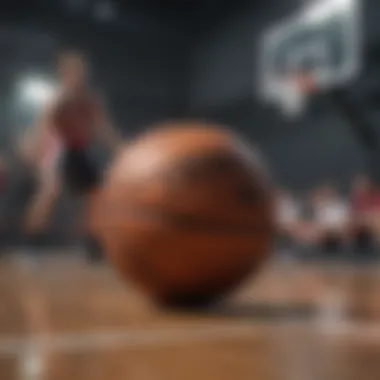
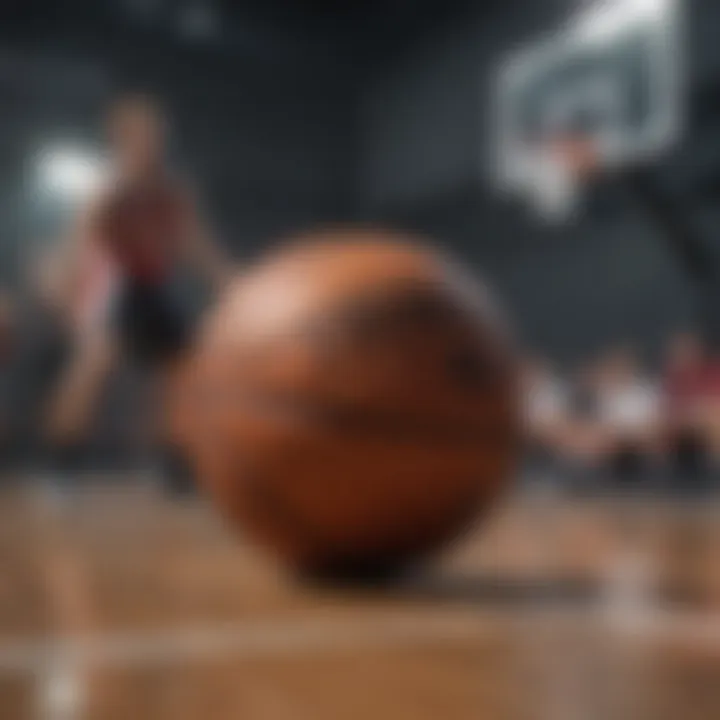
Isolation Drills
Isolation drills focus on individual skill enhancement without the distraction of game-like scenarios. These drills allow players to spend time honing specific techniques at their own pace. They often emphasize fundamental skills such as ball handling, footwork, and control.
One common isolation drill is the stationary dribble, where players practice different dribbling styles while remaining in one place. This allows for focused attention on hand speed and control.
Some key benefits of isolation drills include:
- Improved fundamental skills
- Enhanced confidence individually
- Opportunity to experiment with new techniques
Partner Drills
Partner drills introduce another element of practice. They allow players to engage with a teammate, simulating a more interactive environment. This type of drill often incorporates competition or collaboration, pushing each player to improve.
One example is the back-and-forth drill, where players take turns performing dribbling moves while a partner plays defense. This creates a realistic context for applying skills learned during isolation drills. Benefits of partner drills include:
- Development of reaction skills
- Understanding defensive pressures
- Building teamwork and communication
Game-like Scenarios
Game-like scenarios provide an authentic representation of on-court conditions. These drills typically incorporate elements of both offense and defense, requiring players to apply their skills in context.
One popular drill involves creating a mini-game where players compete in small-sided games. This helps improve decision-making and spatial awareness. The benefits include:
- Real-time application of learned skills
- Increased adaptability to different situations
- Preparedness for transitioning from practice to actual gameplay
Proper skill development through diverse drills is essential for players seeking to elevate their performance on the court.
In summary, drills serve as a foundation for skill development in basketball dribbling. Each type of drill plays a unique role in a comprehensive training program that prepares athletes for both practice and competition.
Integrating Technology into Dribbling Training
In the modern landscape of basketball, technology plays a crucial role in skill development, specifically in dribbling training. The integration of tech tools can streamline training processes and enhance player performance. By utilizing technology, players can gather real-time data about their skills, allowing for tailored feedback and improvement strategies. The effectiveness of a dribbling program can be significantly increased when combining traditional training methods with modern technology.
Use of Training Apps
Training apps are a popular resource for basketball players seeking to improve their dribbling capabilities. These applications offer structured programs that players can follow at their own pace. Many apps provide video demonstrations of various dribbling techniques, which are essential for visual learners. They often include drills tailored to the user's skill level, making it easier for athletes to focus on specific aspects of their game.
Key features of these training apps often include:
- Progress Tracking: Players can monitor their improvement over time, which builds motivation.
- Personalized Drills: Tailored workouts based on previous performances and preferences.
- Technique Analysis: Some apps incorporate feedback features that allow players to assess their form and technique.
By leveraging training apps, athletes can effectively target areas that need improvement and work on them systematically. This can lead to more efficient training sessions and better overall performance.
Video Analysis
Video analysis is another valuable tool in enhancing dribbling skills. This technique involves recording dribbling sessions and then reviewing the footage to identify strengths and weaknesses. Coaches and players can benefit immensely from this process. It creates opportunities for critical evaluation of techniques, which helps clarify what works and what does not.
The advantages of video analysis include:
- Detailed Feedback: Players receive specific insights about their movements and decisions.
- Comparative Studies: Recording games and practices allows players to compare their performance over time.
- Learning from Others: Players can analyze professional athletes' techniques, identifying effective strategies to incorporate into their own game.
Adopting both training apps and video analysis can lead to holistic improvements in a player's dribbling skills. Integrating these technologies into dribbling training not only aids in skill enhancement but also contributes to a deeper understanding of game dynamics.
Common Mistakes in Dribbling Practice
In the realm of basketball, dribbling is not merely about movement; it plays a crucial role in shaping a player’s performance. Recognizing common mistakes helps players refine their technique. Without a strong grasp on proper dribbling practice, even skilled athletes may falter. By shedding light on prevalent errors, players can enhance their overall game. This section highlights two critical pitfalls: over-reliance on one technique and neglecting defensive awareness.
Over-reliance on One Technique
Focusing solely on one dribbling technique can stifle a player's development. While mastering a particular skill, such as the crossover dribble, gives an artistically satisfying edge, it may create weaknesses. A player who becomes predictable can easily be guarded against by opponents, diminishing effectiveness in game situations. Dwelling on one move limits adaptability.
To develop a versatile game, players should practice various techniques, such as the behind-the-back or spin move along with the cross-over. Engaging different styles not only enriches skills but also creates uncertainties for defenders. Consider integrating a combination of drills that purposefully rotate through different techniques. This method nurtures flexibility.
"A single strategy can become a crutch, while diversity in technique creates a well-rounded player."
Neglecting Defense
Dribbling is often viewed only through the lens of offensive skill. However, overlooking defensive strategies during practice limits comprehensiveness. A common mistake is solely focusing on how to dribble past defenders, rather than also understanding defensive movements. This oversight can hinder a player’s ability to create space effectively.
Practicing drills that incorporate defensive pressures is essential. Implementing game-like scenarios where one must read a defender's movements while dribbling builds critical awareness. Using defensive players during practice allows for a more realistic execution of covered techniques. Furthermore, it nurtures a mindset that balances offensive creativity with defensive pressure.
In short, addressing the common mistakes in dribbling practice is vital. Acknowledging the need to diversify techniques and considering defensive aspects enable players to evolve. By avoiding these pitfalls, athletes can better prepare for the challenges faced in real-game situations.
Measuring Progress in Dribbling Skills
Assessing advancements in dribbling skills is vital for players aspiring to improve their game. Measuring progress allows athletes to identify specific areas needing attention and encourages them to stay motivated. This section explores two main aspects of monitoring progress: establishing benchmarks and employing self-assessment techniques.
Establishing Benchmarks
Benchmarks serve as reference points for evaluating skill development. By setting clear and measurable goals, players can gauge their performance over time. Establishing benchmarks involves defining which skills to focus on, such as speed, control, or technique. Each skill should have specific criteria for successful demonstration.
- Speed: Measure how quickly a player can complete a specific dribble drill.
- Control: Assess how well a player maintains possession while executing various dribbling techniques.
- Technique: Observe form and execution during practice sessions.
Regularly reviewing these benchmarks helps players see their progress, which is essential for motivation. A simple practice log can track improvements. This log may include dated entries on drill scores, challenges faced, and areas for future focus.
"Without benchmarks, progress can feel intangible. Players may lose sight of their efforts if they do not occasionally reflect on their development."
Self-Assessment Techniques
Self-assessment is another valuable method for players to evaluate their skills. This method allows individuals to reflect honestly on their performance. Here are some techniques that can help:
- Video Analysis: Recording practice sessions can reveal areas for improvement. Players can review their techniques and notice discrepancies in their execution.
- Drill Journals: Maintaining a journal allows players to document their feelings about their performance. They can note strengths, weaknesses, and progress.
- Peer Feedback: Input from teammates can provide additional perspectives. Players should seek constructive criticism from their peers to understand different views on their skills.
Employing self-assessment techniques empowers players to take ownership of their training. By being aware of their progress, they can adjust their focus, refine their strategies, and set new goals as they advance. Establishing clear benchmarks and engaging in self-assessment leads to a comprehensive understanding of individual development in basketball dribbling.
Psychological Aspects of Dribbling
The psychological aspects of dribbling in basketball are vital for both training and game performance. They encompass the mental preparation and confidence building necessary for athletes to excel. Understanding these elements contributes greatly to a player’s overall ability to perform under pressure, maintain poise, and make informed decisions during gameplay.
Mental Preparation
Preparation is not just about physical readiness; it involves mental conditioning as well. Players must develop a strong mental framework. This entails visualizing successful dribbles and plays before stepping onto the court.
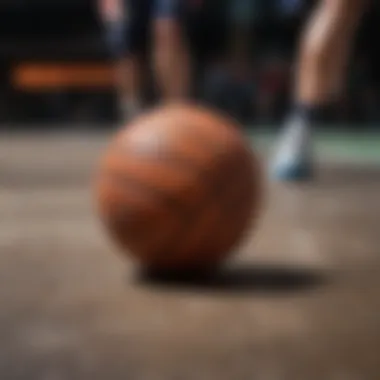
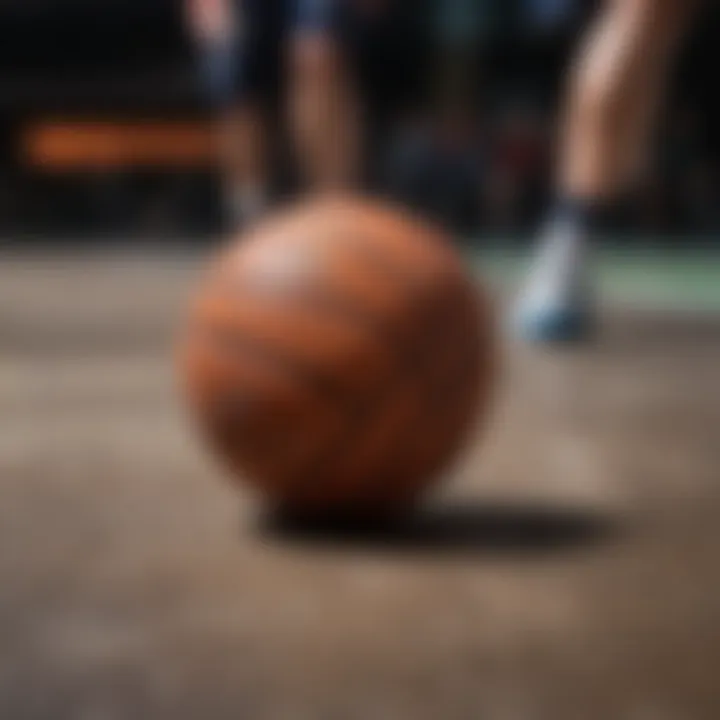
Visualization techniques can greatly enhance performance. Athletes often close their eyes and picture themselves executing dribbles seamlessly against defenders. This process establishes a mental connection between the mind and body.
Additionally, players should engage in positive self-talk to foster a winning mindset. Negative thoughts can hinder performance, while affirmations can boost focus and drive. Regular practice of mindfulness and breathing exercises can also help to elevate a player’s concentration levels.
Confidence Building
Confidence directly influences a player's ability to execute dribbling techniques effectively. A player who believes in their skills is more likely to take risks, make bold moves, and navigate through opposing defenses with ease.
Building confidence can be achieved through consistent practice and mastery of fundamental skills. When a player repeatedly succeeds in drills, it reinforces their belief in their abilities. Moreover, setting achievable goals can provide a roadmap for progress. For instance, improving specific techniques over a set timeframe encourages growth and reinforces self-efficacy.
It is also important for players to accept mistakes as part of the learning process. Committing errors during practice sessions should not lead to frustration but instead be viewed as opportunities for growth. Coaches play a crucial role in this aspect by providing constructive feedback to help players understand and improve from their mistakes.
Ultimately, addressing the psychological elements of dribbling creates a more well-rounded player who can thrive in challenging game situations, thus promoting better performance overall.
The Role of Coaching in Dribbling Programs
In the realm of basketball, coaching serves as an integral component of any dribbling program. It encompasses various aspects that not only fine-tune technical skills but also enhance the overall development of players. A good coach plays a critical role in shaping individual and team performance through effective training regimens. The knowledge and expertise they bring to the court can significantly impact how players learn and apply dribbling skills.
Identifying Strengths and Weaknesses
Coaches possess the ability to evaluate players' skills meticulously. This involves assessing both the strengths and weaknesses of each athlete regarding their dribbling abilities. By observing players during practices and games, coaches can identify specific areas that need improvement. For instance, a player may excel in speed but struggle with ball control. By pinpointing these areas, coaches can tailor training drills to target weaknesses while reinforcing strengths.
This targeted approach is crucial. It helps players focus on particular techniques that require attention. Commonly used methods to assess strengths include:
- Skill assessments: Regularly timed drills to evaluate dribbling speed and control.
- Game simulations: Observing players in practice games to see how they handle dribbling under pressure.
By providing this detailed feedback, coaches facilitate better learning outcomes and help players realize their full potential.
Providing Constructive Feedback
Feedback is the cornerstone of the coaching process. Effective coaches understand that constructive feedback motivates players to improve. This feedback should be specific, focusing on particular aspects of dribbling skills. For instance, instead of saying a player is "not good enough," a coach can specify that the player needs to work on keeping their head up while dribbling.
Successful feedback methods include:
- Positive reinforcement: Acknowledging improvements, no matter how small, encourages players to keep striving for excellence.
- Guided corrections: Demonstrating how to correct mistakes helps players understand what is needed.
- Regular check-ins: Coaches should consistently touch base with players to discuss progress and areas that still need work.
"Feedback should not just be about what went wrong but also about what went right. It builds confidence and a willingness to learn."
Ultimately, good coaches foster an environment where players feel safe to make mistakes and are eager to learn from them. This approach cultivates essential dribbling skills while enhancing players' overall game performance.
Dribbling in Game Situations
Dribbling skills are crucial during actual games as they heavily influence a player’s performance. Mastering dribbling in game situations means knowing how to maneuver effectively under the pressure of real-time scrutiny. This skill goes beyond mere technique; it encompasses decision-making and adaptability. Whether navigating through defenders or making quick passes, a player’s ability to dribble properly can dictate the outcome of plays and ultimately the game itself.
Applying Skills Under Pressure
In a game environment, players face intense pressure from defenders, teammates, and the game clock. This requires athletes to execute their dribbling skills with precision while also maintaining their composure. Players must get comfortable with the following aspects:
- Decision-Making: Quick assessments of the court are essential. Players must determine when to pass, shoot, or drive towards the basket. Making the correct choice consistently enhances game efficiency.
- Spatial Awareness: Understanding the positioning of others on the court can guide dribbling decisions. Awareness allows players to create space or exploit defensive weaknesses.
- Ball Control: During pivotal moments, maintaining ball control can be challenging but vital. Techniques learned in practice need to be instinctively applied during games.
Even the best players can falter under pressure without adequate preparation. Thus, simulating game-like scenarios in training drills can yield improved performance during real games.
Reading Defenses
Understanding how to read defenses is an incomparably valuable skill for any player. Recognizing the defensive strategy being employed allows a player to tailor their dribbling approach effectively. Some important points include:
- Defensive Schemes: Familiarizing oneself with man-to-man and zone defenses can provide insights into how to exploit gaps in coverage. Different strategies require distinct dribbling responses.
- Defender Positioning: Observing where defenders position themselves helps in crafting effective dribbling techniques. For example, if a defender leans towards one side, a quick change of direction can lead to an open route.
- Anticipation: Developing the ability to anticipate a defender's movement allows an offensive player to capitalize on openings. This aspect combines skill, instinct, and experience to improve offensive opportunities.
Effective dribbling requires not only skill but also a keen understanding of the dynamic nature of basketball, especially during game situations. Focusing on tactical execution can significantly alter the course of a game.
In summary, being proficient in the game involves mastering both mental and physical components of dribbling. Whether it is handling the ball under pressure or making quick reads, these skills collectively contribute to a player's effectiveness on the court.
Future Trends in Basketball Dribbling Programs
As the game of basketball evolves, so do the training methodologies that support player development. Future trends in basketball dribbling programs are vital to stay ahead of competition and enhance athletic performance. This section will explore emerging training techniques and the impact of analytics, which are shaping how players improve their dribbling skills in modern contexts.
Emerging Training Techniques
Innovations in training techniques are providing players with unique ways to hone their dribbling abilities. Here are some significant developments:
- Skill-Specific Equipment: New tools and devices now exist to enhance dribbling practice. Products such as weighted basketballs or dribbling goggles help players focus on technique while improving hand-eye coordination.
- Virtual Reality Training: Immersive experiences allow players to engage in simulations. They can practice their dribbling against virtual opponents. This approach helps them adapt to different game situations without the risk associated with physical scrimmages.
- Dynamic Training Environments: More coaches are utilizing unconventional settings for practice. Using uneven surfaces or challenging terrains can help athletes develop better control. These conditions force players to adapt and improve their footwork and agility while dribbling.
- High-Intensity Interval Training (HIIT): Integrating HIIT practices into dribbling drills boosts endurance while focusing on skill development. This method trains players to maintain dribbling excellence even when fatigued, which is crucial during intense game scenarios.
Each of these techniques emphasizes a tailored approach to dribbling that encourages creativity, adaptability, and skill refinement.
The Impact of Analytics
Analytics in basketball are transforming not just the strategy but also how dribbling is taught and assessed. The integration of data plays several crucial roles:
- Performance Tracking: Coaches can monitor players’ progress through data collected during practice sessions. Metrics like dribbling speed, frequency of successful crossovers, and even the effectiveness of different techniques provide insights into areas needing improvement.
- Strategic Adjustments: Coaches can analyze opponents’ defensive patterns using statistical analysis to prepare players better. Understanding how defenses react allows for tailored dribbling drills designed to counteract specific defensive strategies.
- Customized Training Plans: Data-driven insights enable the creation of individualized training programs. These programs focus on each athlete's strengths and weaknesses, creating a personalized learning path that enhances their dribbling capabilities more effectively.
- Game Simulation Analytics: By reviewing game footage and analyzing dribbling choices made during play, players can identify successful strategies and areas for improvement. This video analysis is instrumental for players to refine their skills in a game-like context.
The synergy of analytics and practice not only boosts players' dribbling skills but also arms them with a deeper understanding of game dynamics, promoting smarter decision-making on the court.
Future trends in basketball dribbling programs emphasize adaptability and a data-informed approach. Embracing these elements is essential for players aiming to excel in an increasingly competitive environment.
Finale
The conclusion of this article serves to encapsulate the core themes and insights regarding basketball dribbling programs. It plays a crucial role in reinforcing the importance of mastering dribbling techniques and the overall structure of such training. Effective dribbling not only enhances individual performance but also contributes significantly to team dynamics during games. It is essential to recognize that the insights presented throughout this guide are designed to equip players with the necessary skills to excel in various game situations.
Summarizing Key Points
In summary, we have explored multiple facets of basketball dribbling. Key points include the following:
- The historical context of dribbling illustrates its evolution and significance in modern basketball.
- Effective dribbling encompasses critical components such as ball control, footwork, and body positioning.
- Various techniques, including crossover, spin move, and in-and-out dribbles, are indispensable tools in a player’s arsenal.
- A structured dribbling program can be tailored to different skill levels, ensuring that all players benefit from targeted training.
- The integration of technology, from training apps to video analysis, enhances skill acquisition and allows for better self-assessment.
- Coaches play a vital role in identifying areas for improvement and providing feedback for future development.
These elements collectively highlight the interconnected nature of skills, coaching, and technology in advancing dribbling proficiency.
Encouraging Continuous Improvement
Encouraging continuous improvement in dribbling skills involves fostering a mindset of growth and resilience. Players should actively seek opportunities to practice regularly, understanding that mastery takes time and dedication. Setting measurable goals can provide direction and motivation. Here are some practical ways to enhance skills over time:
- Consistent Practice: Schedule daily or weekly sessions focused specifically on dribbling techniques.
- Video Feedback: Utilize video analysis to scrutinize your form and technique, allowing for more precise adjustments.
- Seek Feedback: Regularly solicit feedback from coaches and peers to gain external perspectives on your progress.
- Set Goals: Establish short and long-term goals to keep motivation high and track improvements.
- Diverse Drills: Incorporate a variety of drills that mimic real-game situations to adapt skills effectively under pressure.
By maintaining a commitment to improvement, players can elevate not only their dribbling capabilities but also their overall performance in basketball.







